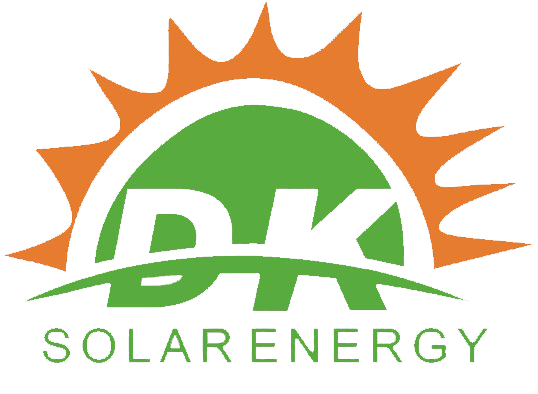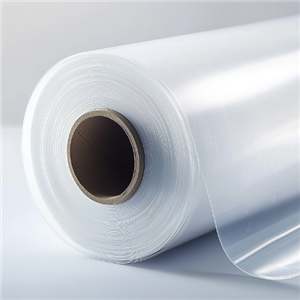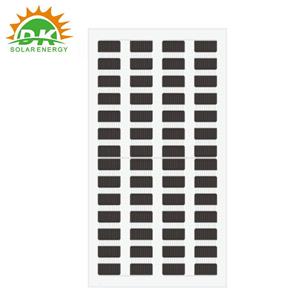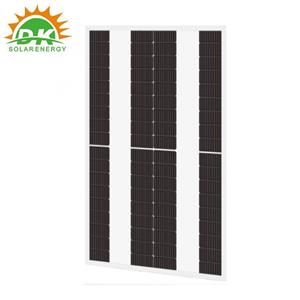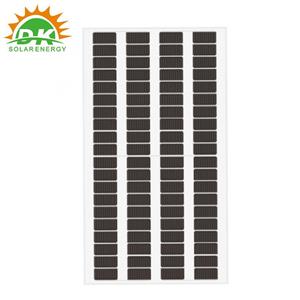Perovskite solar technology will account for 29% of the global PV market by 2030
Perovskite has emerged as a new and efficient solar cell material in the past decade, with a power conversion efficiency of 25.7%
Perovskite photoactive materials have inherent advantages to achieve high power conversion efficiencies, such as long carrier diffusion lengths, high carrier mobility, low exciton binding energies, high absorption coefficients, and bandgap tunability by exchanging precursor components.
Another important advantage of these materials is that films can be deposited by solution methods at low temperatures, which can be produced economically and efficiently on flexible polymer substrates by high-throughput roll-to-roll processes.
Perovskite solar technology is expected to exceed 29% of the global PV market by 2030.
The use of plastic foils also provides a new set of advantages for PV products, where non-cost-related factors can provide significant leverage, such as light weight, high specific power, and ease of integration with various surfaces.
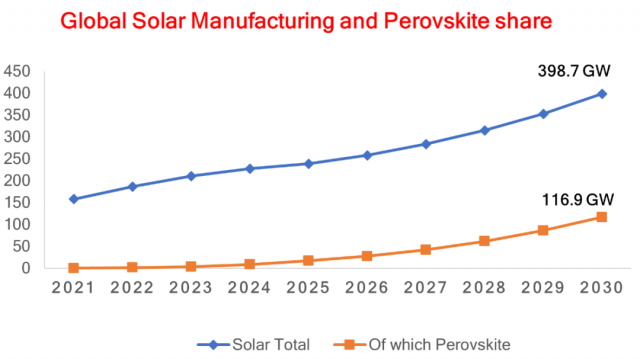
An important factor that sets perovskite apart from mature PV technologies is the possibility of a high level of product customization, in line with the customer's needs in a specific application. This could allow longer incubation of technology while simultaneously entering the market, thus easing the challenge of large-scale market entry.
An example of a customized flexible perovskite solar module is shown below.
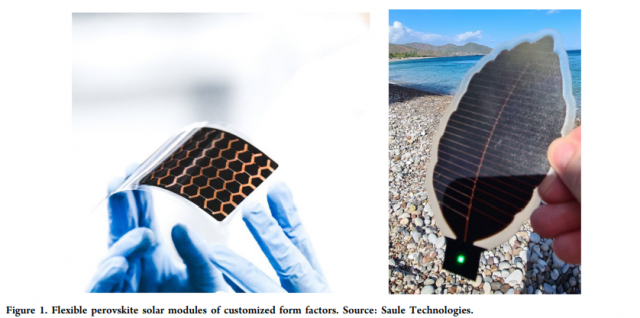
Perovskite solar cells are an excellent solution to power consumer electronics, especially the Internet of Things (IoT) ecosystem, where billions of sensor nodes are connected to the power grid.
Current research trends are moving toward low-power devices and protocols that improve energy utility to increase network coverage, reduce latency, minimize energy losses, and improve data reliability. The iot market is growing exponentially, creating a vast network of connected devices, including smartphones, kitchen appliances, industrial robots, healthcare devices or connected cars. By the end of 2020, there were an estimated 11.3 billion connected iot devices worldwide, a number that should grow to 27 billion by 2025.
It should be noted that many iot applications do not require continuous data transfer. A common approach is to collect data and store it in memory, then distribute the packets at short intervals. Currently, the vast majority of wireless detectors off the grid use batteries. There are a lot of battery products on the market; However, their capacity and lifetime are always limiting factors in the range and frequency available for data transmission. In addition, the additional maintenance cost of regularly replacing batteries must be considered.
Indoor photovoltaics (IPV), which capture ambient light and convert it into electricity, offer a promising alternative to energy supply.
For this to be commercially viable, a PV cell needs to provide more energy over its lifetime than is stored in a typical cell, such as an 1860 mWh CR2450 button cell or a 3500 mWh AA cell. Also, this should be provided within the smallest area available, as manufacturers are looking to reduce the size of their products. Therefore, high power density under low light conditions is one of the key requirements for these applications. In addition, flexibility in design and shape is often required, as seamless integration of energy harvesting elements is a common requirement for product designers. From a reliability certification point of view, indoor PV needs to pass less stringent tests; The recently formulated IEC 63163 aims to address this problem.
Solar cells work very differently from typical outdoor use, where light intensities are typically several orders of magnitude higher. For this reason, conventional PV technologies, such as C-SI, are not suitable for these applications. Perovskite with adjustable bandgap and good photoelectric properties proved to be ideal for low light use with excellent performance parameters.
While the iot market is large and growing fast, determining the best use of energy harvesting is not easy. The use case will define the power budget that needs to be provided by the solar module. The environment in which the device is placed and the dimensions of the product define the boundary conditions for the energy that can be harvested. Most importantly, integration should make sense from a business perspective, so a careful cost/benefit analysis is required, taking into account environmental impacts. To address these issues, Saule's approach is to look at the largest and fastest growing segments of iot applications and categorize them by location, sector, device type, and value proposition. Table 1 summarizes some of the identified opportunities.
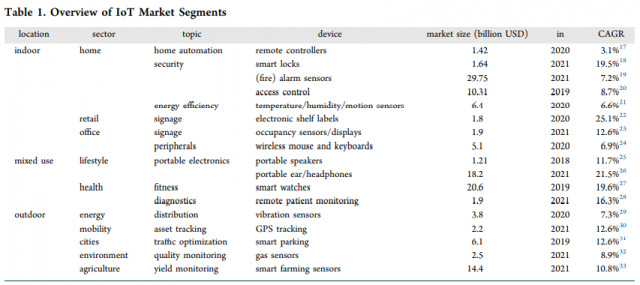
Market size and growth are certainly not the only important aspects to consider. From the manufacturer's point of view, it is important to develop the product with the least amount of customization because of the additional risks and costs that come with it. In addition, how to monetize the extra power budget is very important. With all this in mind, electronic shelf tags seem to be one of the most attractive options. An example of the perovskite-based electronic shelf tag (PESL) developed by Saule and the pilot production facility used to manufacture the flexible perovskite PV are shown below.

The global smart price tag market is expected to grow from USD 1.8 Billion in 2020 to USD 7.1 Billion in 2026 at a cumulative annual growth rate (CAGR) of 25.1%.
Smart price tag technology is relatively new to the market and is undergoing various implementation tests by retailers. Using electronic shelf tags instead of paper solutions already offers a number of advantages. Key points include reducing labor costs and eliminating human error, as prices can be assigned to stock keeping units (SKUs) and automatically updated. Currently commercially available electronic shelf tags are typically displayed using electronic paper, which is an excellent option for minimizing the energy requirements of such devices.
E-paper requires energy just to update the contents of the display, which means that traditional ESL can last quite a long time as long as the pricing of the item does not change. The typical product on the market today has an average life of five years and updates its price 1 or 2 times a day.
One might think that this is sufficient for most purposes; Since 2020, however, the retail world has changed in many ways. E-commerce has been a steadily growing field over the past decade; However, especially since the outbreak of the pandemic, its importance has increased significantly.
With the advent of new technology, the increase in online shopping has put traditional retailers at an even greater disadvantage. Digital stores can collect vast amounts of data about their customers and shopping habits, and they can use this information to optimize their pricing, even multiple times a day, to achieve maximum profitability. Online marketplace giant Amazon changes product prices every 10 minutes, according to price intelligence firm Profitero.
Another factor is that disruptions in global supply chains make products less available - shifting the balance between supply and demand more frequently.
As icing on the cake, record high inflation has further fuelled more frequent pricing changes. The annual average inflation rate in the euro area was 8.9% in July 2022, but it could be as high as 11.0% for unprocessed foods and over 20% in the Baltic States, Eurostat reported.
Brick-and-mortar stores are finding these problems increasingly difficult to deal with. Even if they use the same strategy to update prices, electronic shelf tags can quickly drain their battery capacity. This is where PV cell enhanced solutions can provide a significant impact, enabling traditional retailers to compete with their digital counterparts.
The added value of additional generated profits is expected to far outweigh the additional costs including solar cells, power management systems and the use of renewable batteries. In addition, epaper manufacturers and product sizes in the market are well positioned to define ESL's profile sizes, with the highest demand for 1.54 ", 2.13 ", and 2.66 "display sizes. Production of several million units per year means steady demand, and the targeted small PV cell size makes it easy to implement. Therefore, the authors believe that it is an excellent choice to address the entrance of the perovskite PV market.
